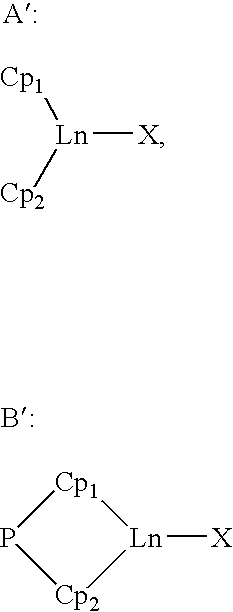Catalytic system for obtaining conjugated diene/monoolefin copolymers and these copolymers
a catalytic system and conjugated diene technology, applied in the field of catalytic systems, can solve the problems of reduced molecular mass of copolymers obtained, deactivation of catalytic systems, and difficulty in copolymerization of conjugated diene and monoolefin
- Summary
- Abstract
- Description
- Claims
- Application Information
AI Technical Summary
Benefits of technology
Problems solved by technology
Method used
Image
Examples
example 1
Synthesis of the Organometallic Complex [Me2Si(C5H4)(C13H8)]NdCl(OC4H8)x
[0101]Synthesis of the Ligand Me2Si(C5H5)(C13H9):
[0102]The ligand Me2Si(C5H4)(C13H9), where Me denotes a methyl group, was synthesized according to an operating method described in the literature (Alt et al J. Organomet. Chem. 1996, 509, pp. 63-71).
[0103]Synthesis of the Salt [Me2Si(C5H4)(C13H8)]Li2(OC4H8)2:
[0104]12.1 ml of 1.6 M BuLi are added at ambient temperature to a solution of 2.8 g of the ligand Me2Si(C5H5)(C13H9) in 150 ml of THF. The solution is stirred for 4 h, then the THF is evaporated. The residue is dried in a vacuum then washed while cold with two 50 ml portions of heptane. A yellow solid is isolated. 1H NMR analysis of this solid was performed with a “BRUKER 300 MHz” spectrometer in the range THF-d8: δ(chemical shift in ppm)=7.85 (d, J 8 Hz, 2H, Fl), 7.77 (d, J 8 Hz, 2H, Fl), 6.79 (dd, J 8 Hz and 7 Hz, 2H, Fl), 6.44 (dd, J 8 Hz and 7 Hz, 2H, Fl), 6.15 (m, 2H, Cp), 5.83 (m, 2H, Cp), 3.62 (THF), ...
example 2
Copolymerization of Butadiene and Ethylene by Means of the Organometallic Complex of Example 1 and Various Co-Catalysts
[0108]Three tests according to the invention of the copolymerization of ethylene and butadiene were performed according to the operating method described below, together with a “control” test of the homopolymerization of ethylene.
[0109]A solution composed of 300 ml of toluene, a specific quantity xc (mg) of the organometallic complex of the formula [Me2Si(C5H4)(C13H8)]NdCl(OC4H8)x prepared in Example 1 and of a co-catalyst according to the invention and then a mixture of ethylene and butadiene with a molar fraction y (%) of butadiene were introduced in succession into a reactor under an argon atmosphere. The internal pressure of the reactor was maintained at 4 bar when the fraction y of butadiene so permits. The temperature of the polymerization reactor was maintained at 80° C. for the polymerization.
[0110]After a reaction time t (min.), polymerization is terminated...
example 3
Copolymerization of Butadiene and Octene by Means of the Organometallic Complex of Example 1 and Various Co-Catalysts
PUM
| Property | Measurement | Unit |
|---|---|---|
| atomic number | aaaaa | aaaaa |
| molar ratio | aaaaa | aaaaa |
| molar ratio | aaaaa | aaaaa |
Abstract
Description
Claims
Application Information
 Login to View More
Login to View More - R&D
- Intellectual Property
- Life Sciences
- Materials
- Tech Scout
- Unparalleled Data Quality
- Higher Quality Content
- 60% Fewer Hallucinations
Browse by: Latest US Patents, China's latest patents, Technical Efficacy Thesaurus, Application Domain, Technology Topic, Popular Technical Reports.
© 2025 PatSnap. All rights reserved.Legal|Privacy policy|Modern Slavery Act Transparency Statement|Sitemap|About US| Contact US: help@patsnap.com



